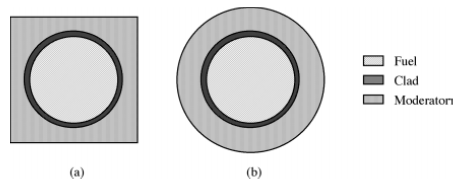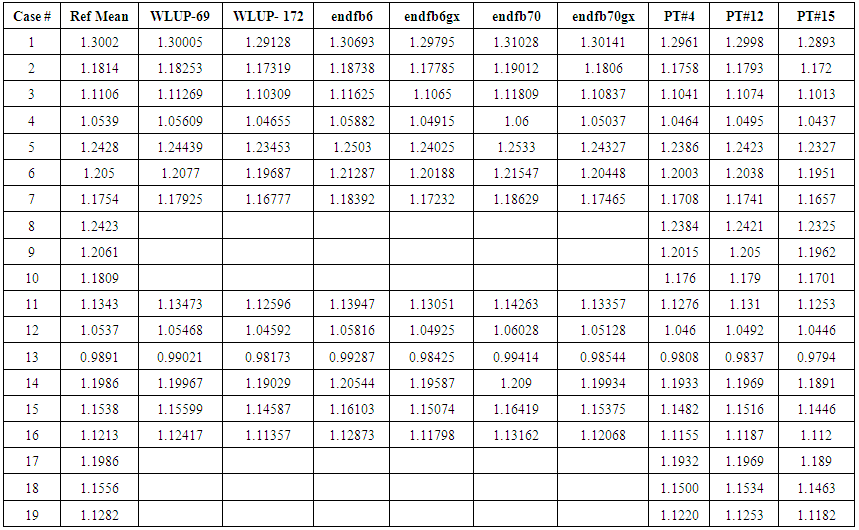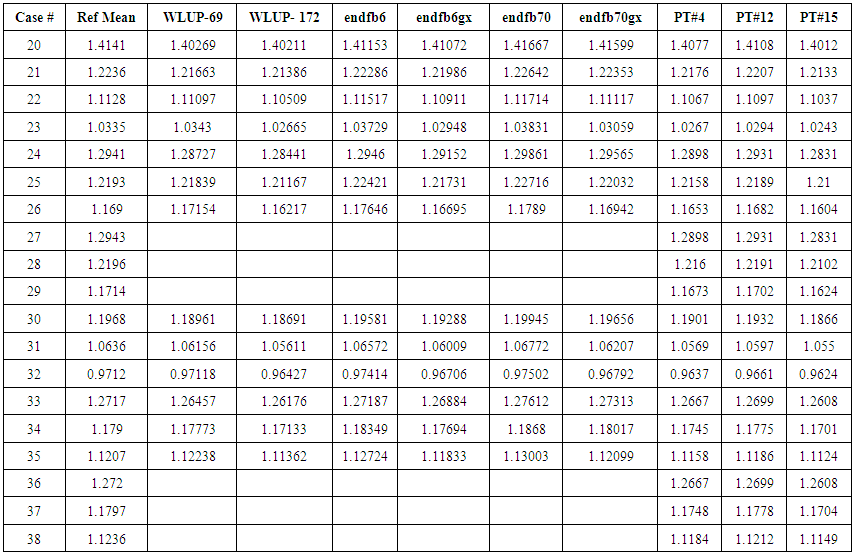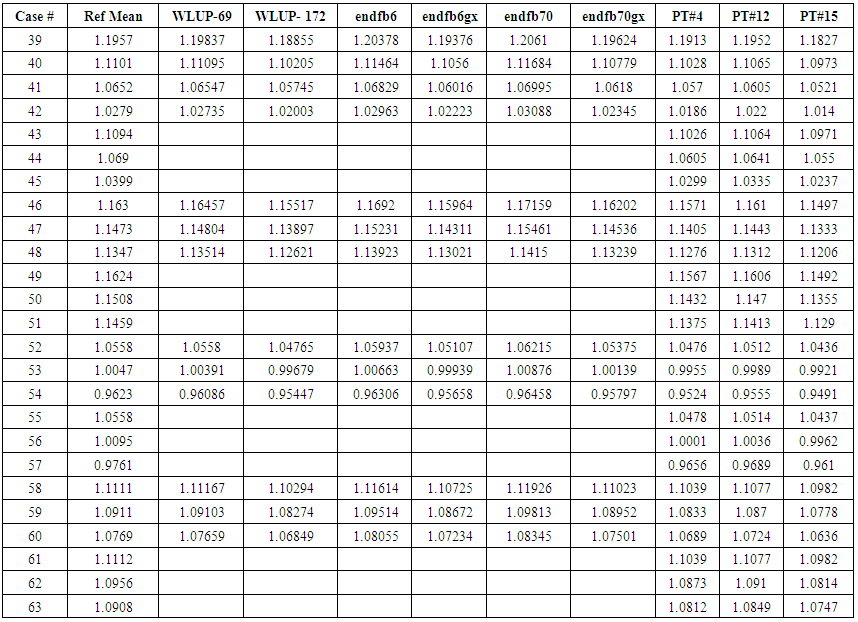-
Paper Information
- Paper Submission
-
Journal Information
- About This Journal
- Editorial Board
- Current Issue
- Archive
- Author Guidelines
- Contact Us
Journal of Nuclear and Particle Physics
p-ISSN: 2167-6895 e-ISSN: 2167-6909
2016; 6(4): 73-79
doi:10.5923/j.jnpp.20160604.01

Neutron Multiplication Factor Calculation for PWR MOX Fuel Pin Cells with WIMS-D5 Code
Riham M. Refeat, Esmat A. Amin
Safety Engineering Department, Egyptian Nuclear and Radiological Regulatory Authority (ENRRA), Cairo, Egypt
Correspondence to: Riham M. Refeat, Safety Engineering Department, Egyptian Nuclear and Radiological Regulatory Authority (ENRRA), Cairo, Egypt.
| Email: |  |
Copyright © 2016 Scientific & Academic Publishing. All Rights Reserved.
This work is licensed under the Creative Commons Attribution International License (CC BY).
http://creativecommons.org/licenses/by/4.0/

Thermal reactor physics lattice cell code WIMS-D5 is widely used in many laboratories for thermal research reactor and power reactor calculations. It uses the Wigner-Seitz approximation for the pin cell calculations. This approximation had been extensively applied to UO2 pin cells but it was pointed out in previous studies that it can produce erroneous results if it is used for a pin cell in MOX fuel. The present paper investigates the use of WIMS-D5 code to calculate the neutron multiplication factor for MOX fuel pin cells. The data used are derived from the Burn-up Credit Benchmark (Phase IV-A) conducted by the Nuclear Energy Agency (NEA). The calculations are performed using the updated WIMS-D libraries. An outer scattering boundary condition is proposed to overcome the effect of the Wigner-Seitz approximation deficiency in case of MOX fuel. The results obtained are compared with the mean calculated neutron multiplication of the benchmark and with results obtained using other versions of WIMS code and other nuclear data libraries. The results of the present work showed that most of the results obtained using WLUP-69 and endfb70gx are better than the other libraries. However, the maximum difference obtained from these libraries compared to the reference mean is of order 500 pcm. On the other hand, the addition of an outer scattering boundary improved the results obtained using WLUP-172 and endfb6gx to a great extent and caused slight improvement for other libraries. This indicates that by using the appropriate library and the addition of a scattering outer boundary, the Wigner Seitz approximation for the MOX pin cell in WIMS-D5 can produce reasonably accurate results.
Keywords: Wigner-Seitz approximation, WIMS-D5 code, MOX fuel
Cite this paper: Riham M. Refeat, Esmat A. Amin, Neutron Multiplication Factor Calculation for PWR MOX Fuel Pin Cells with WIMS-D5 Code, Journal of Nuclear and Particle Physics, Vol. 6 No. 4, 2016, pp. 73-79. doi: 10.5923/j.jnpp.20160604.01.
Article Outline
1. Introduction
- The Nuclear Energy Agency (NEA) of the Organization for Economic Cooperation and Development (OECD) conducted in 1998, the Burn-up Credit Benchmark (Phase IV-A) [1, 2] that describes calculations to be performed for the analysis of mixed-oxide (MOX) fuel pins in a two-dimensional, infinite lattice configuration. The benchmark included 63 criticality calculation studies of three fuel types: Case A that is reference (first generation) MOX derived from Light Water Reactor UO2 recycle, Case B that is MOX enrichment based on disposition of weapons-grade Plutonium, and Case C that is later-generation MOX that would result from MOX recycling. For each fuel type, calculations were performed for specific isotopic compositions predicted for various burnup states and cooling times, with different sets of nuclides present. They were chosen to cover combinations of the following parameters for the three MOX fuel types:
- 1) Burn-up:– Fresh fuel.– 20 GWd/teHM.– 40 GWd/teHM.– 60 GWd/teHM.2) Cooling:– One year.– Five years.3) Fuel representation:– Major and minor actinides.– Actinides and fission products.The pin cell geometry for the specified benchmark is presented in Figure (1). It consists of a 0.412 cm radius fuel pellet surrounded by 0.063 cm thick zircalloy-4 cladding, with no intervening air gap between the fuel and the cladding. The fuel pin is within a square cell of 1.33 cm side dimension, and is surrounded by water. Reflective boundary conditions are modeled on all sides of the pin cell geometry. The isotopic compositions for all the materials of the pin cell are taken from reference (2).
 | Figure (1). Geometrical specification of MOX fuel pin cell for PWR |
2. WIMS-D Library Update Project (WLUP)
- In the early 1990s, the WIMS-D Library Update Project (WLUP) was initiated [4]. This project was supported by the International Atomic Energy Agency (IAEA) and consisted of a large number of participants. The objective of WLUP was to provide updated working nuclear data libraries compatible with the WIMS-D family of codes and the other thermal reactor lattice cell codes. This would enable scientists and reactor designers to use the updated evaluated nuclear data files for research and power thermal reactor calculations. Two libraries were produced namely; WIMSD-IAEA-69 group cross section library (WLUP-69) and WIMSD-IAEA-172 group cross section library (WLUP-172). The libraries are based mainly on ENDF/B-VI rev. 8, JENDL-3.2 and JEF-2.2 evaluated nuclear data libraries. The new libraries (WLUP-69 and WLUP-172) represent an improvement in several aspects [4]; the number of materials increased to 173 and a library containing 172 energy groups is generated in addition to the standard 69 group library. Moreover, improvements in the evaluation of cross sections and related parameters, and burnup chains are performed.In 2002 corrected WIMSD libraries are considered on the frame of WLUP [5] namely endfb6 and endfb6gx which are 69-group and 172-group WIMSD-formatted libraries. The two libraries are based only on the ENDF/B-VI rev. 8 evaluated nuclear data library.In 2006, ENDF/B-VII.0 evaluated nuclear data library was released [6], it contains data primarily for reactions with incident neutrons, protons and photons on almost 400 isotopes, based on experimental data and theory predictions. There are several advances over the previous ENDF/B-VI library like:(1) New cross sections for U, Pu, Th, Np and Am actinide isotopes, with improved performance in integral validation criticality and neutron transmission benchmark tests;(2) More precise standard cross sections for neutron reactions on H, Li, B, Au and for U fission;(3) Improved thermal neutron scattering;(4) An extensive set of neutron cross sections on fission products; (5) Extension of many neutron and proton induced evaluations up to 150 MeV; On the bases of the ENDF/B-VII.0 evaluated nuclear data library, new WIMSD libraries were added to WLUP [5] namely endfb70 and endfb70gx which are 69-group and 172-group WIMSD-formatted libraries.
3. Wigner Seitz Approximation
- The Wigner-Seitz approximation [7] uses a cylindrical outer boundary and white boundary conditions to replace the square moderator boundary associated with a fuel pin. The exact geometry of a square pin cell is shown in Figure (2a), while the Wigner-Seitz approximation is shown in Figure (2b). The radius of the outer cylindrical boundary for the equivalent Wigner-Seitz cell is chosen such that the volume of the moderator is precisely the same as in the exact pin cell. Due to computational difficulties associated with applying reflective boundary conditions on a cylindrical outer boundary, White boundary conditions are applied in the approximate model. This approximation has been found to be acceptable for UO2 fuel pin-cell modeling, but in previous studies [1] it was found that this approximation can produce erroneous results for MOX fuel pin-cell modeling.
 | Figure (2). Exact and Wigner-Seitz representations of a pin cell |
4. Results and Discussions
- In order to investigate the capability of WIMS-D5 code to be used with MOX fuel pin cell, the calculations are performed on two phases. Phase 1:The neutron multiplication factor for most of the 63 cases specified in the original benchmark is calculated using the three sets of nuclear data libraries. The first set includes WLUP-69 and WLUP-172, the second set includes endfb6 and endfb6gx and the third set includes endfb70 and endfb70gx. The cases that include curium are not executed because the libraries used in this work do not include the cross section data for the curium-245 isotope. For the other cases, no nuclides are substituted or omitted from the calculations. The results are compared with the mean calculated neutron multiplication obtained from 37 individual contributions participated in the benchmark. Also, the results are specifically compared with those of participants (4 and 12) who used WIMS7B code and JEF2.2 nuclear data library, and participant (15) who used WIMS/ABBN code and FOND-2 nuclear data library. The results obtained are shown in tables (1, 2 and 3).Tables (1), (2) and (3) show that most of the results obtained using WLUP-69 and endfb6gx are better than the other libraries. The maximum difference obtained from these libraries compared to the reference mean is equal to 575 and 470 pcm which is acceptable when compared to those obtained from participants 4, 12 and 15, which are equal to 1114, 761 and 1610 pcm respectively. There is no actual verification data such as critical experiments or core tracking exists for the specified benchmark problem, so the true solution is not known. It is shown in reference (1) that there is a large spread in the results obtained from the 37 participants, for example the difference of results obtained for case B20 from the reference mean ranges from 20 pcm to 651 pcm. So the value obtained for this case using WLUP-69 (575 pcm) lies within this range.
 | Table (1). Multiplication factors for MOX composition A |
 | Table (2). Multiplication factors for MOX composition B |
 | Table (3). Multiplication factors for MOX composition C |
 | Table (4). Multiplication factors for MOX composition A with outer boundary |
 | Table (5). Multiplication factors for MOX composition B with outer boundary |
 | Table (6). Multiplication factors for MOX composition C with outer boundary |
5. Conclusions
- The present paper investigated the use of WIMS-D5 code to calculate the neutron multiplication factor for MOX fuel pin cells. The data used are derived from the Burn-up Credit Benchmark (Phase IV-A) conducted by the Nuclear Energy Agency (NEA). The calculations are performed using the updated WIMS-D libraries based on the ENDF/B-VI.8 and ENDF/B-VII.0 nuclear data libraries, namely; WLUP-69, WLUP-172, endfb6, endfb6gx, endfb70 and endfb70gx. An outer scattering boundary condition is proposed to overcome the effect of the Wigner-Seitz approximation. The results obtained are compared with the mean calculated neutron multiplication of the benchmark and with results obtained using other versions of WIMS code and other nuclear data libraries.The results of the present work showed that most of the results obtained using WLUP-69 and endfb70gx are better than the other libraries. However, the maximum difference obtained from these libraries compared to the reference mean is of the order 500 pcm. On the other hand, the addition of an outer scattering boundary improved the results obtained using WLUP-172 and endfb6gx to a great extent and caused a slight improvement for the other libraries. This indicates that by using the appropriate library and the addition of a scattering outer boundary, the Wigner Seitz approximation for the MOX pin cell in WIMS-D5 can produce reasonably accurate results.
 Abstract
Abstract Reference
Reference Full-Text PDF
Full-Text PDF Full-text HTML
Full-text HTML